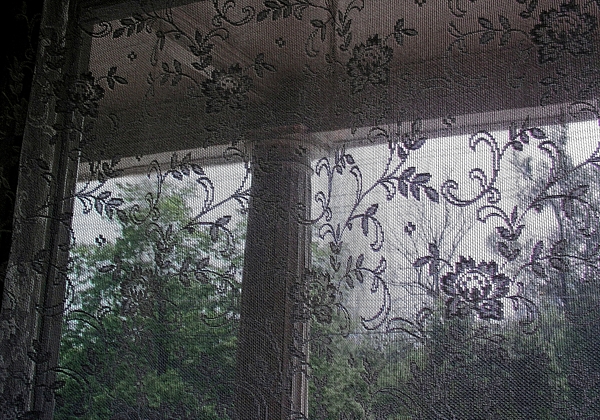Drawing inspiration from such disparate works as Ingres paintings from the early 19th Century, a poster I remember seeing all over New York 40 years ago for a Joffrey Ballet production, and those pulsating hippie light shows of the Sixties, I shot all these photos in a single session. I wanted in each to merge my model with a projected image — but do it my way, no Photoshop — to create a modern image with classic beauty and some sense of mystery. Perhaps at first glance one thinks “How was that done?” but the perceptive viewer will see the images for what they are: photographs made with photographs. And proud photographs, not paintings.
It was a delight to find when they were exhibited in the 2011 edition of curator Tina Maneca’s Exquisite Corpse, an October show that opened during the Jersey City Artists Studio Tour, that each photo was a favorite of at least one visitor to the show. Of course some in the series drew positive comments from many people, but it was nice to know that each had at least one admirer. All were printed on metal, with glossy finish and ready to hang with no frame, and “In Her Realm,” below, is my largest such print to date — 45 inches wide.
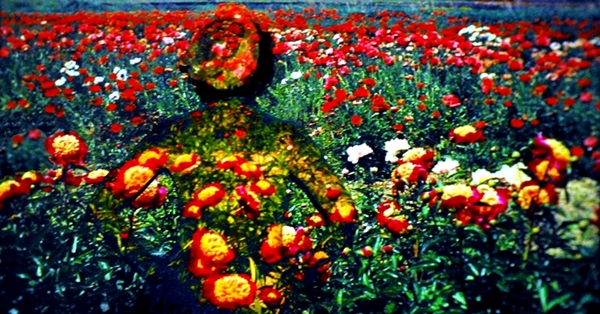
Below is “Recognition.” It’s printed 24 by 24.
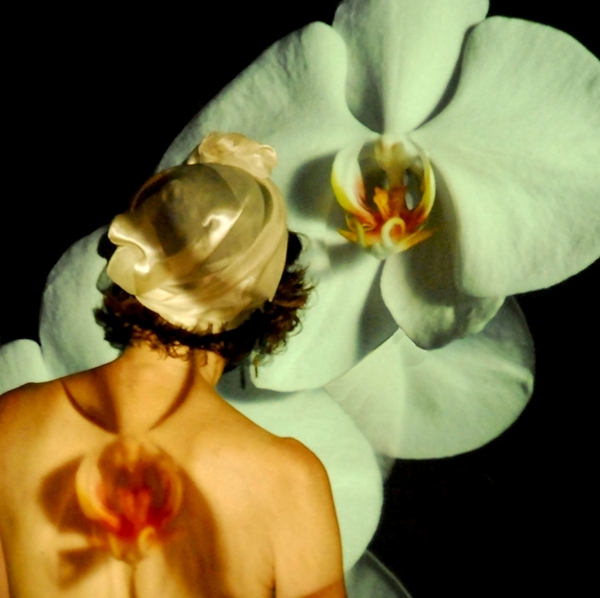
“Sosei,” below, is also 24 by 24.
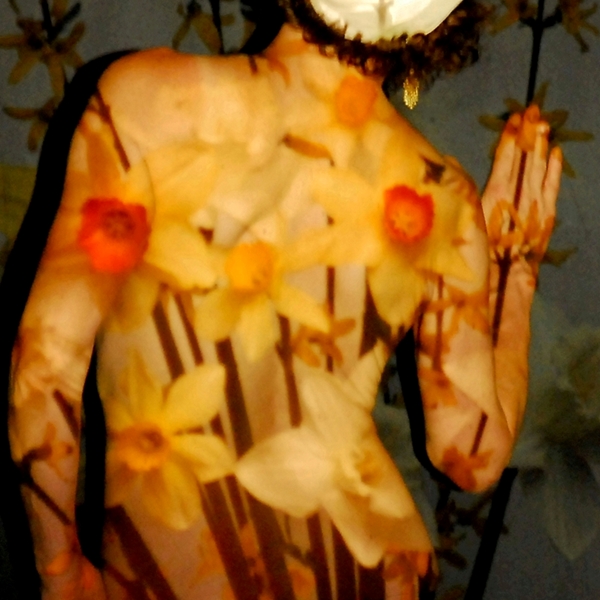
Below is “In the Garden,” printed smaller, perhaps 15 inches wide.
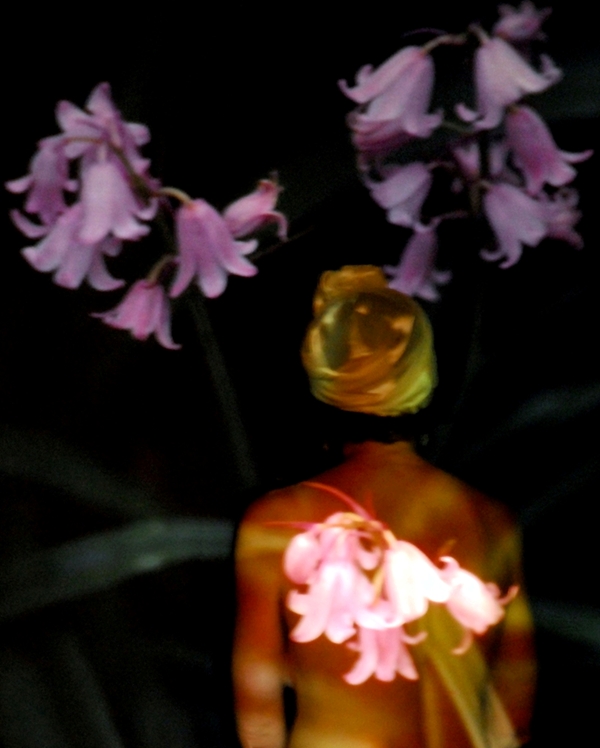
“Forest Dawn” was not seen in Exquisite Corpse, as the print was damaged by a worker taking down the previous show in the space.
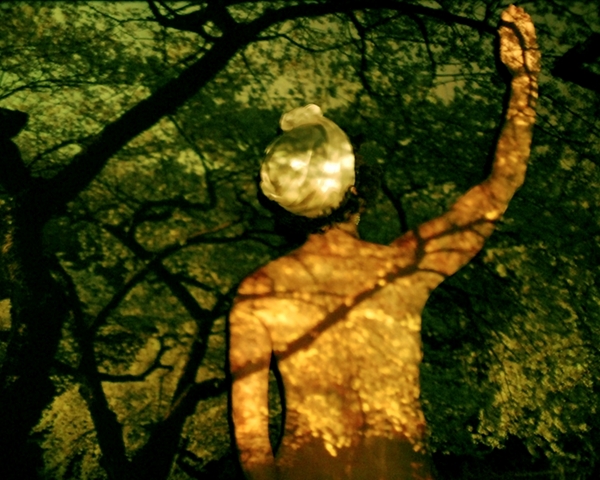
Fire? Ecstasy? Cherry blossons? Wagner’s surging music? All there. “Greeting Spring” is large, about 36 inches wide.
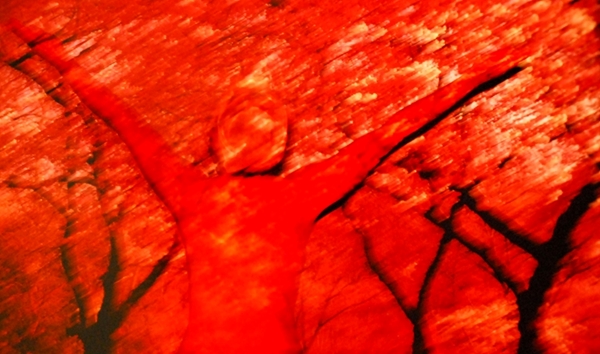
“Aspiration” is perhaps 20 inches wide.
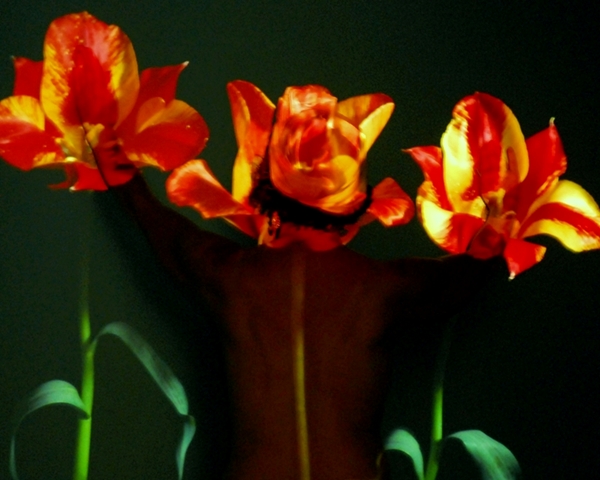
“Discovery” is about 20 inches wide, too.
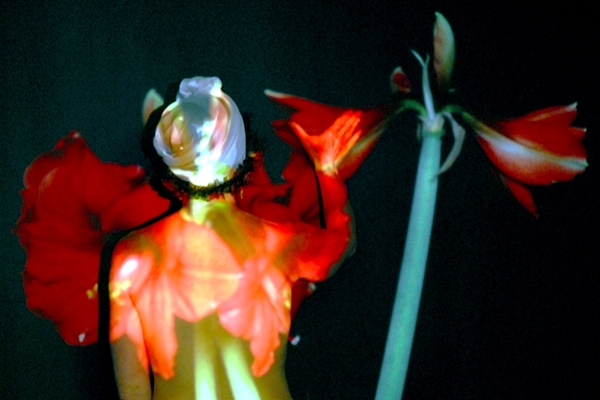
“Peace” is 20 inches square, and was used in one of the many 3-artwork assemblages that curator Tina Maneca put together.
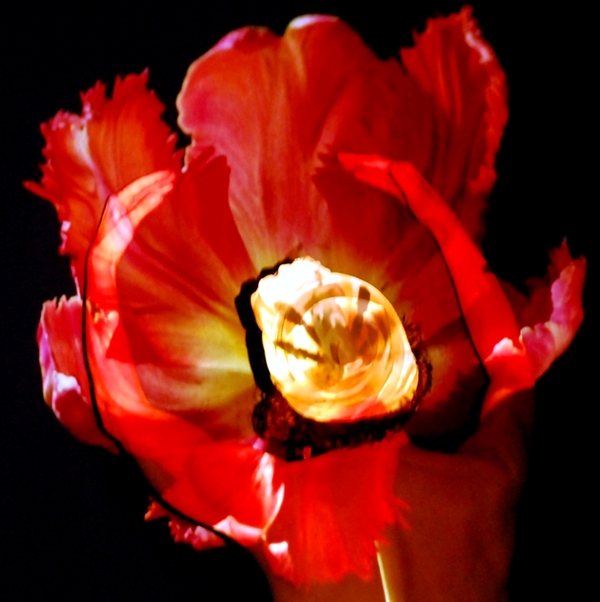
Below is “Peace” and the works shown with it. Each assemblage in Exquisite Corpse has a “head,” a “torso” and “legs.”
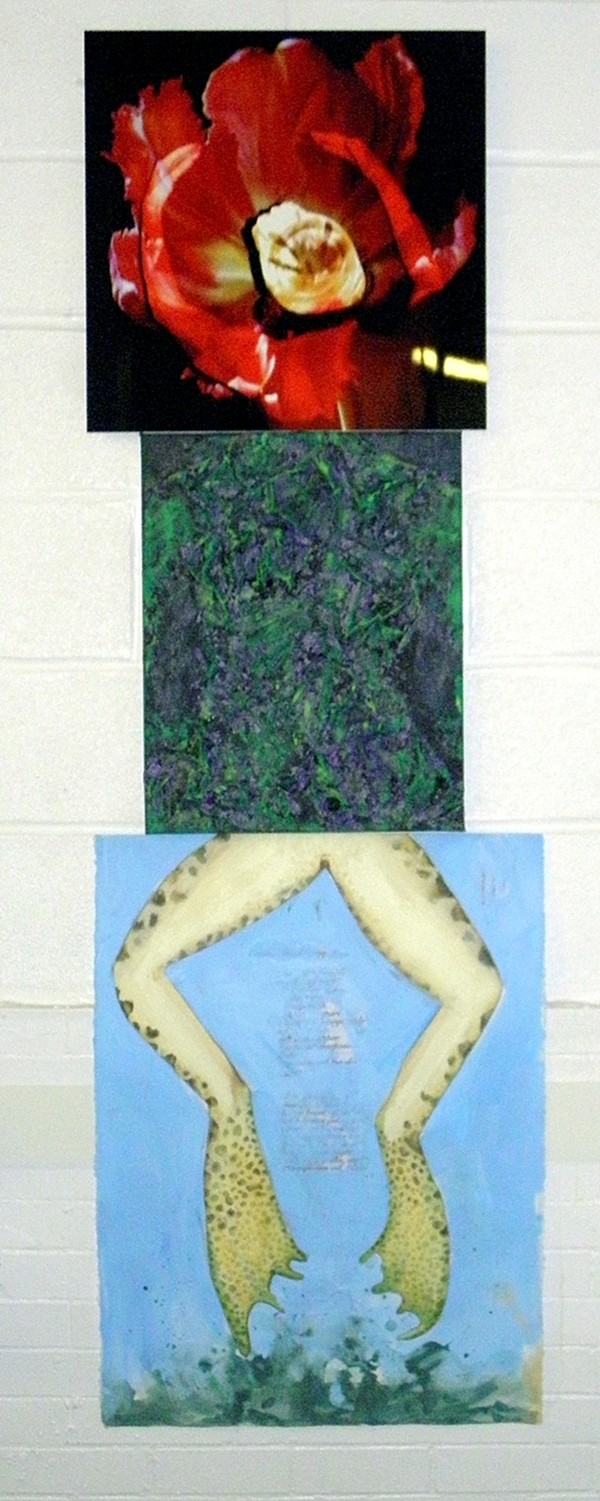
My model visited the show. In her realm, indeed!
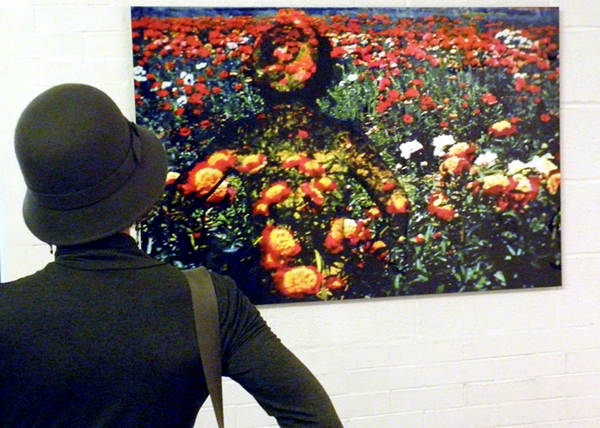
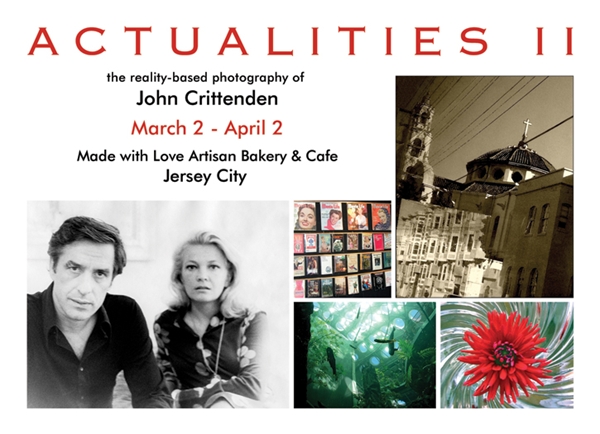
I’m pleased to be having my second solo show, less than a year after my first, at Made With Love Artisan Bakery & Cafe in Downtown Jersey City. Included in Actualities II are my portraits of John Cassavetes and Gena Rowlands, Liv Ullmann and Judy Collins, taken in the mid-1970s when I was a young journalist.
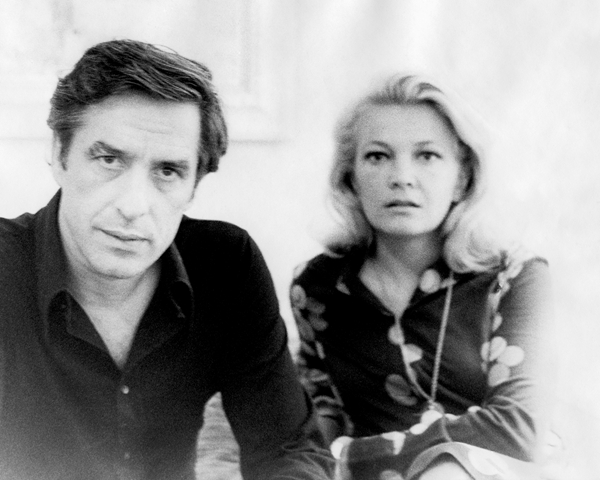
I was lucky to secure the 9 a.m. slot to interview John Cassavetes and Gena Rowlands the morning after “A Woman Under the Influence” — many consider it to be the greatest of the films they made together — debuted at the 1974 New York Film Festival at Lincoln Center. The interview was done in their hotel suite on West 58th Street, and they were still waking up when we began. He appeared first, and soon she came into the room and he presented her to me with admiration and pride in his voice. She seemed shy, almost fragile, and was even more strikingly beautiful than when acting on screen. At the end of the interview, I pulled out my Minolta 35mm film camera and took a few pictures without missing a beat. Having chatted for the better part of an hour, they were comfortable, weren’t asked to pose, and I didn’t use a flash. There was plenty of soft incandescent in the room and morning light was coming through the curtains. And so I captured the images of the director now remembered as the father of independent film in America, as well as a fine actor, and his actress wife, who is still beautiful and still making interesting movies today.
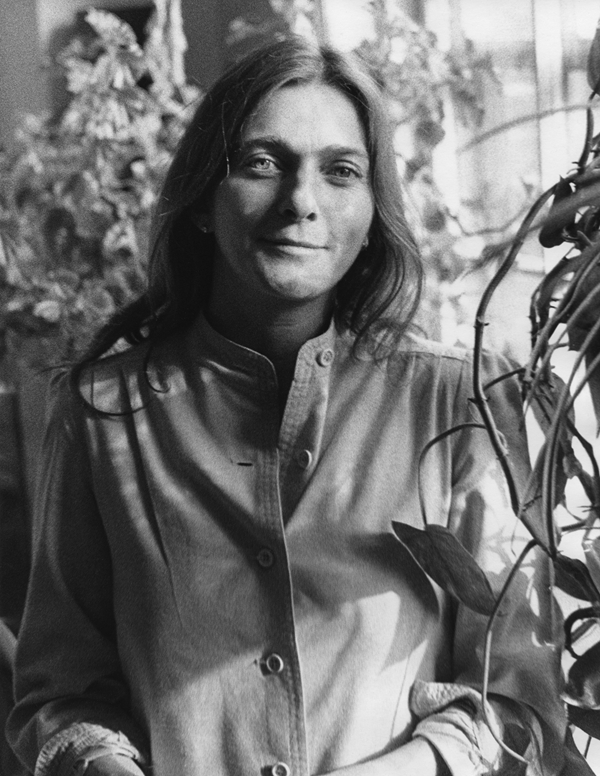
Judy Collins welcomed me into her apartment on Manhattan’s Upper West Side to discuss a film, “Antonia: A Portrait of the Woman,” which she produced and Jill Godmilow directed. The 1974 feature documentary tells the compelling but not widely known story of Antonia Brico, who in 1938 was the first woman to conduct the New York Philharmonic.
Born in The Netherlands, Brico grew up in California and was an accomplished pianist when she left high school, and already had experience in conducting. She graduated from the University of California, Berkeley, in 1923 and in 1927 entered the Berlin State Academy of Music, becoming the first American to graduate from its master class in conducting. She debuted as a professional conductor with the Berlin Philharmonic Orchestra in 1930. In 1934, back in the States, she was appointed conductor of the new Women’s Symphony Orchestra, which in 1939 became the Brico Symphony Orchestra after it admitted men. She conducted at the New York World’s Fair. But there were discouragingly few opportunities.
In 1942, she settled in Denver, Colorado and spent the rest of her life there, founding several local musical groups, conducting the Denver Symphony Orchestra, playing a major role in the city’s cultural life. She also taught piano, and this is where Judy Collins met her. She was one of Antonia Brico’s piano students.
I think it was extraordinary that Judy Collins, whose own musical career was going full swing in 1974, invested time and money in making a film tribute to a woman who was a hero in her life and who, she felt, had not gotten the artistic recognition she deserved in a field that was, and still is, predominantly male. And Judy Collins made sure the film was done right. “Antonia: A Portrait of the Woman” was nominated for an Academy Award in the documentary category. Antonia Brico died in Denver in 1989, at age 87.
After our interview, I photographed Judy Collins among her houseplants in her south-facing living room. Our visit was a particular thrill for me, of course, for hers was and is one of the great voices of my generation, and that interview was done only seven short years after her album “Wildflowers” was on every turntable in every college dorm room in America, including my own.
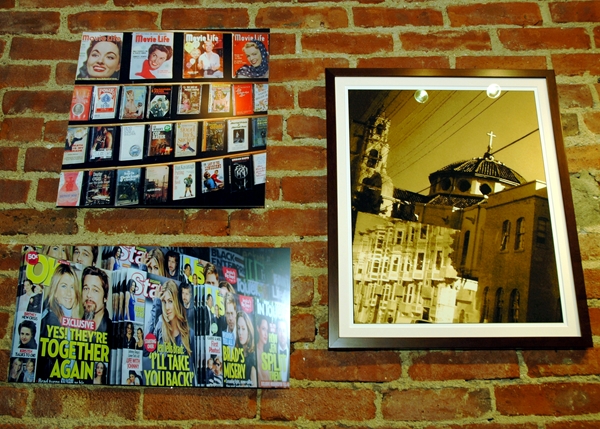
These photographs were taken in San Francisco, a city I dearly love. “In the City of Saint Francis” is on the right, a sepia-toned rendition of a single image. I think it has some feeling of the movement of the bus I was on when I took the exposure. I knew we would soon pass Mission Dolores, a tiny adobe church built in 1791 and the city’s oldest surviving structure, and I wanted to ready to snap it. I was shooting wildly, wondering what images I might get, kind of priming the camera. It turned out that this was the more interesting shot, a lucky shot totally unplanned. It’s a bit off-putting in color, with a phantom red digital zipper of words running through the middle, but when I took the color out and saw it in black and white I knew I had something. The lower left section of the image is the reflection in the bus window of the line of bay-windowed apartment houses across the street. The large church building with the cross on top is the modern basilica of Mission Dolores Church. Altogether, it is a vision of the city as it has looked, in this spot, for more than a half-century.
The subject is popular media in the photos at left, which are printed on metal and “float” on the wall, their corners as sharp as any print. Artists working in all mediums are fashioning comments these days on the supposed end of the print era, and these are mine. The relatively benign movie magazines from the 1940s and ’50s and the paperbacks with eye-catching covers displayed below them in the top photo were in the window of a used book store on Post Street. The magazines in the lower photo promise us, in January 2010, the latest “misery” in the lives of Jennifer and Brad and Angelina, none of which seems to have come to anything. I guess news was slow that week, the competition as cut-throat as ever. Whether such pages will still be viewed in one’s hands in 10 years time or will only be seen on screens I do not know. But I’m sure celebrity culture will continue to serve up the same formula “inside” exclusives. Inquiring minds will always want to know.
I’ve always been deeply ambivalent about the real place called Hollywood and about Los Angeles in general. When I first flew out for a visit, about 1970, I had a window seat and during our low approach to LAX I looked out over mile after flat mile of superblocks divided by major streets, all viewed as if through a light chartreuse filter. This was before clean air laws and mandated emissions controls on cars. The air burned my eyes on two occasions during my week-long stay, and I wondered how so many people could live there seemingly satisfied with conditions I could hardly tolerate. Fast forward about 40 years and I’m still not in love with L.A., but I do manage to have fun when I’m there.
This photo was snapped in February 2007 during the week before the Oscars were handed out. Hollywood Boulevard was closed to traffic for many blocks around the Kodak Theater, creating snarls and backups on all the other major roads, but I was able to find and park in one of three lots adjoining the back of the Hollywood Wax Museum so I could attend one of the screenings in a festival showcasing new Italian films at Grauman’s Chinese, on the same crowded block as the Kodak. When I got back to the car, night had fallen and the lights were on, and I knew I had to preserve this vision of Hollywood, a company town where billboards touting new product seem bigger and more numerous than anywhere else in the world, and where every actor hopes to achieve the immortality of John Wayne, Elvis Presley, Marilyn Monroe, Charlie Chaplin. I was especially taken with the way the museum’s mural incorporates the utility lines on the sides of the building. Nothing gets in the way of promotion in Tinseltown.
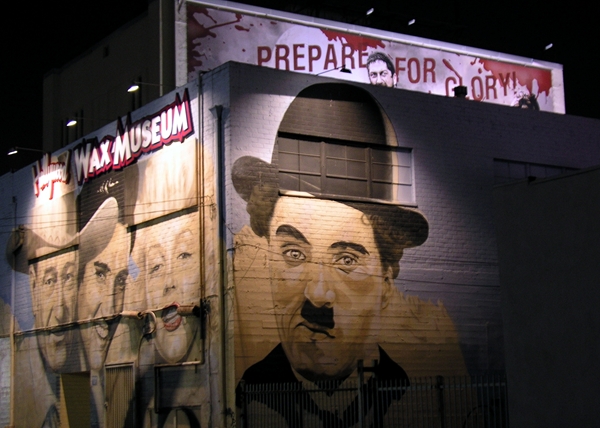
Just after New Year’s, when Celeste Governanti, the proprietor of Made with Love Artisan Bakery & Cafe, invited me to mount a photography show in the far-off month of June, she asked if I could include one or two things that related to Fathers Day. Hmmmmm, I wondered. I’ve never really done genre photos — I’ll let someone else do greeting cards and stock photos of beaming models and rented offspring. Still, I had a request to fill and I kept it in the back of my mind. Soon I was off to San Francisco for the Noir City 8 Film Festival at the Castro Theater, and while I was having a late breakfast between Sunday screenings of bank heist and blackmail melodramas in glorious 1950s black and white I noticed two dads and their daughter at the next table. They live in Oakland, have been partners for eight years, and were having brunch before taking Amelia to Samoan church for an afternoon service. I promised them a family smile shot, which was easy to snap against a fancy grilled doorway next door to the restaurant on busy Castro Street, and also posed them under the huge rainbow flag that flies above Castro and Market. Then we all looked down Market Street, with its palm trees and signs and street car cables and traffic — the reality of life there. Our shoot took only 15 minutes and their family has two portraits and I got a Dads Day shot for my show. I call this “Fathers Show Us the Way.”
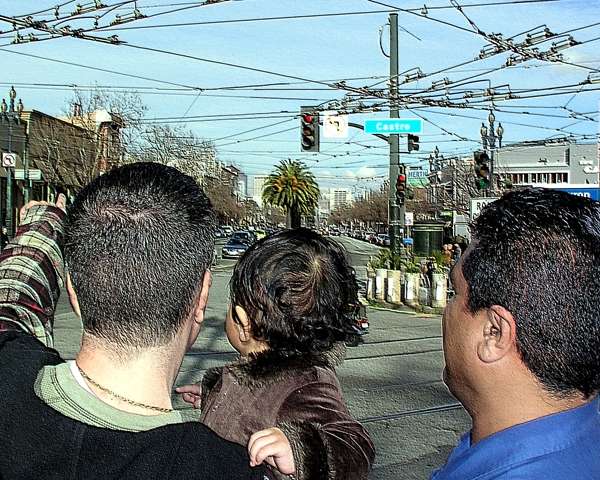
Some weeks later, I became acquainted with a couple in my neighborhood who have a little boy who’s just graduated from being a rug rat to zooming around on his own two feet. I’ve had this setup in my mind’s eye since seeing it in another photographer’s display a couple of years ago. I don’t feel at all guilty about stealing his idea; he probably stole it from someone else. Besides, the feet in his shot were so perfectly lovely, so sentimentalized, so “commercial.” I’d never do that, and I haven’t. This shot was taken Memorial Day afternoon at the park at the end of the block. The boy’s feet will never again be this small as he grows and grows and grows, and he’ll always have this picture as a memento of his babyhood. No doubt that he’s with Daddy. I call it “Tootsies.”
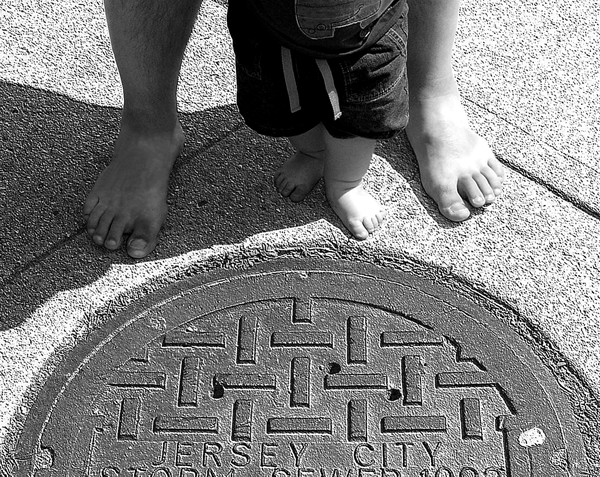
And here’s how “Tootsies” looks in the window at Made with Love. The family adores it, and so does Celeste. Fits perfectly with Fathers Day, doesn’t it.
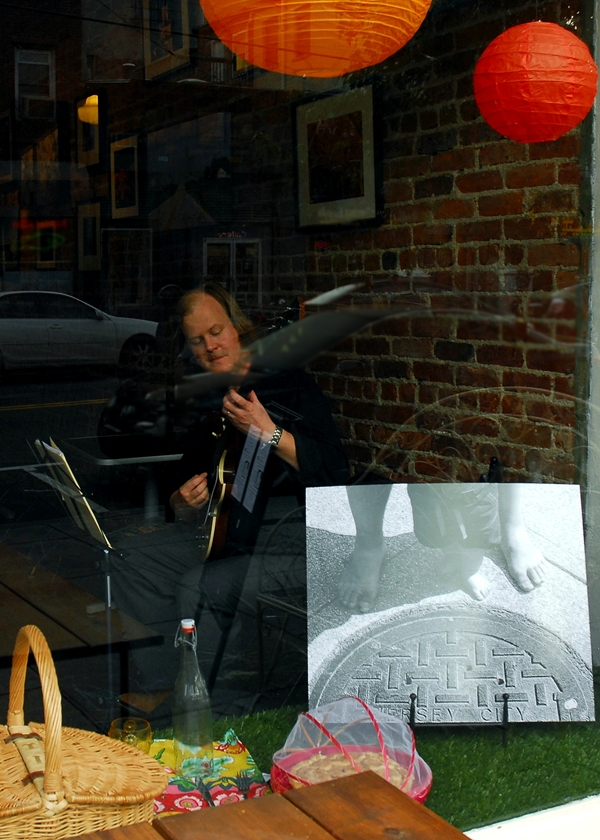
Included in “Actualities” is a portrait of a New Yorker I snapped in Chelsea a couple of Octobers ago. Walking east in the high 20s after attending the PhotoPlus Expo at the Javits Center, I noticed a pigeon sitting on a railing just off the sidewalk in a niche in the front of an old apartment house. He was perfectly lit in the late afternoon sun, and as pedestrians bustled by he didn’t seem to move except to swivel his head. When I paused, he shot me one of those “You looking at me?” looks. Would he fly away, or stick around long enough for me to pull out the camera and turn it on? New York pigeons are tough old birds, and I’m sure he’d stood his ground in the face of things far more menacing than my lens.
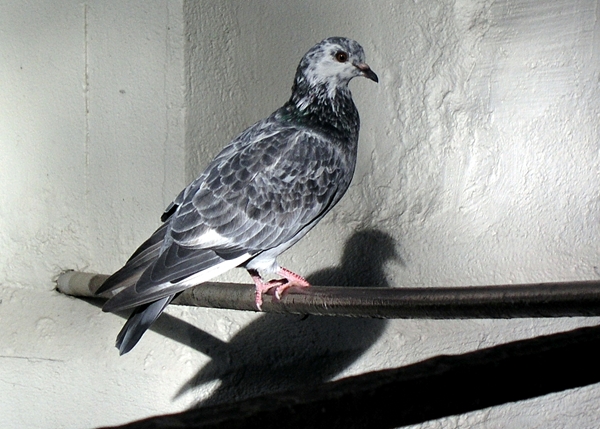
For “Actualities,” on display at Made With Love Artisan Bakery & Cafe in Downtown Jersey City through June 28th, I had the photo printed on metal, choosing the “sheer” option. This allows some of the metal to show through in “high key” areas of a photo. It took me a couple of days after the delivery to warm to the results, and I’m still not 100 percent liking it. In my opinion, a successful photo has to look good in all levels of light, and my New York pidgeon loses some of its punch under low light. Below is a photograph of the metal print in the “Actualities” show. See what you think.
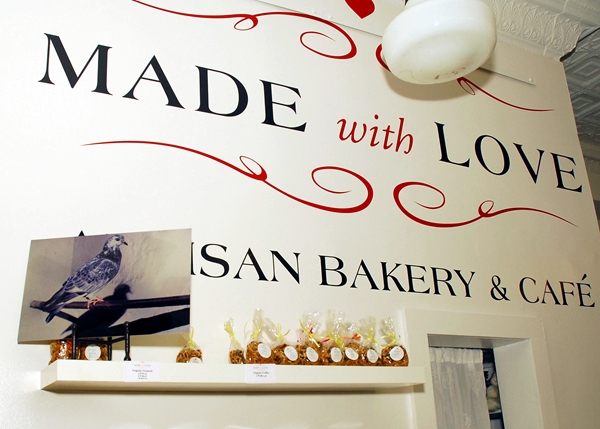
You’re invited to my first solo show, on the walls during the whole month of June at Made With Love Artisan Bakery & Cafe, in Downtown Jersey City. An opening party is planned for Saturday, June 5, from 7 to 9 p.m. Susan Newman designed my postcard. 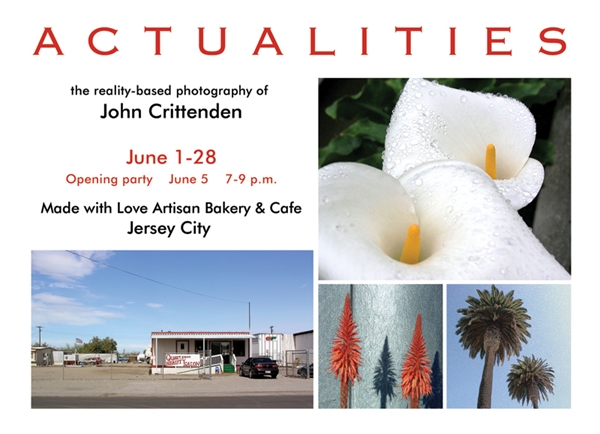
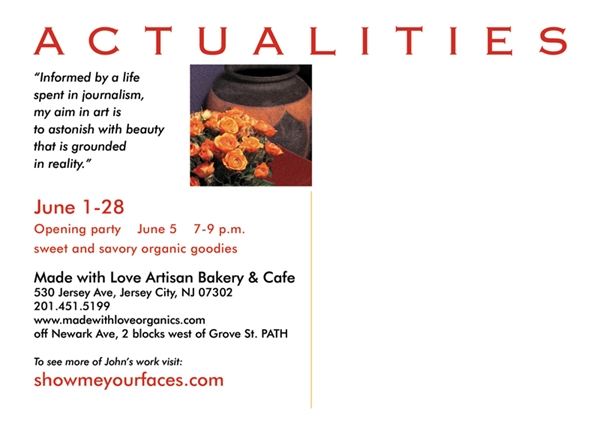
During a recent trip to Oklahoma to reconnect with my native state, I had just visited the little town of Perry, a few miles east of I-35, and was heading due east on my way to a left turn that would take me straight north to Ponca City, when a biker flew past me. Impulsively, I tried to keep up and photograph him at the same time. (Autofocus makes this possible, but I don’t recommend it in heavy traffic.) I drove above 70 mph, and sometimes hit 80, and followed him for miles but never got close, and then came over a hill and he was gone from sight. But I’ve got this to remind me of Oklahoma’s big sky and wide open spaces, where the air is clean and you can see for miles.
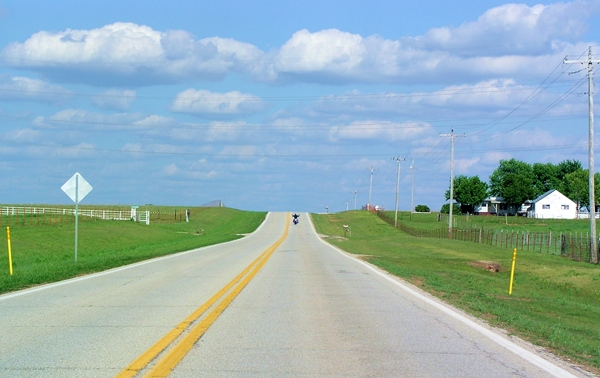
Perhaps my life as a photographer would be easier, or at least lighter, if I were more comfortable with certain conventions. I well remember when photographs weren’t considered serious unless they were black and white and presented in a white or cream mat behind glass inside a black wood or metal frame. Later, natural wood frames became acceptable, and now white wood frames are seen everywhere. I understand some of the reasoning. You’re supposed to be presenting the photo, featuring it while protecting it, and there should be nothing distractingly different in a room that contains eight or ten or a dozen photographs. Each image should be a focus and nothing should take away from it. I do get that. But there are so many options available today that I can’t accept uniformity as any kind of operating principal. Not with photographs being printed on metal, on plastic, on canvas, and on other media. And so I wrestle with deciding how I want to see every particular image on a wall.
Below is a photograph I took in southwestern Pennsylvania only a few miles north of the border with Maryland. We are looking out to the porch and trees beyond a roadway from inside the Stone Inn, a circa 1822 building on the Braddock Road, which dates from the 1750s and was incorporated into one of the nation’s first improved highways built by the federal government. Started in the early 1800s, what became known as the National Road carried multitudes of settlers and travelers from Baltimore west to Ohio. Now a large and comfortable restaurant with a bed and breakfast operation upstairs, the inn has always been a stopping place for rest and hospitality. I found the dining room to be one of those places with a pleasant, calculated historic feel but no particular antique vibe. I found the outside view compelling. The thrill, if you feel it, is in looking out over a byway that’s been busy with commerce every single day for centuries and a landscape that has hardly changed except as it grew and died back and then renewed itself. I wanted to somehow capture that, without being too literal or stuck in any particular year.
After much debate with myself, I had this photograph printed large and on canvas, and it drew many favorable comments in my first solo show of my work, in June at Made With Love Artisan Bakery & Cafe in Downtown Jersey City. Looking out across time is someting many of us enjoy doing, and this will add an architectural element to any wall it’s on.
